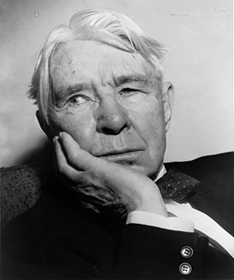|
Carl Sandberg
Answer
to Name
This Famous Person Game - February 2014
|
 |
Fog
The fog comes
on little cat feet.
It sits looking
over harbor and city
on silent haunches
and then moves on.
Remember Carl Sandberg from English class at school?
|

|
The poet Carl Sandberg was identified by: Julie Kimbrell of the Old School Antique Mall in Sylva, N.C.; Jim Pruett of Eastbrook Flea Market in Montgomery, Ala.; Teresa P. Bland; Scott and Carolyn Brown of Memories Flea An'Tique Mall in Prattville, Ala.; Ted Carlton of Utah; Maureen Ouellette; Gene Sorbo of St. Petersburg, Fla. (no relation to Kevin “Hercules” Sorbo); Randy Chase of The Antique Chasers.
On Jan. 6, 1878 in Galesburg, Ill., Carl Sandberg could have been born with the name of Carl Johnson, but his emigrant Swedish parents, August and Clara Johnson, previously changed their names to Sandberg. August felt there were too many Johnsons in his railroading profession so he changed the family name to avoid confusion.
Young Carl was only educated through the eighth grade before he had to leave school and go to work. He never graduated from college, although he attended, but he did receive three honorary degrees from colleges during his lifetime. In addition, he had several schools named after him.
Carl worked as a shoeshine boy, porter, milk wagon driver, bricklayer, hotel servant, coal heaver, hired hand on a wheat farm, ice harvester and a salesman of pictures for stereoscopes. He served briefly in the army in the Spanish-American War in Puerto Rico but never saw battle. He was also a hobo for a while, riding the rails and collecting stories and songs. Some of those folksongs ended up in his book, The American Songbag, published in 1927, and Sandberg performed them while playing the guitar or banjo at recitals or lectures.
There is an eagle in me that wants to soar, and there is a hippopotamus in me that wants to wallow in the mud.
Despite his formal 8th grade education, in his lifetime, Sandberg won three Pulitzer Prizes and a Grammy. Two of his Pulitzers were for poetry (The Complete Poems of Carl Sandburg and Corn Huskers), and the third was in 1940 for his four-volume book, Abraham Lincoln: The War Years. (This was preceded by his two-volume book, Abraham Lincoln: The Prairie Years.) The Grammy was awarded to him in 1959 for Best Performance of Spoken Word for reading Lincoln Portrait by Aaron Copland.
Life is like an onion. You peel it off one layer at a time, and sometimes you weep.
Due to his travels around the country and seeing the plight of the poor and laborers, Sandburg joined the Social Democratic Party, and he also wrote brochures, articles, and speeches for the International Workers World. He met his future wife Lilian Steichen at a Social Democratic Party office in 1907, and they later had three daughters together.
A politician should have three hats. One for throwing into the ring, one for talking through, and one for pulling rabbits out of if elected.
Carl Sandberg’s non-rhyming, meter-less, free-verse style of poetry was unsettling to many initially. Was it a story, or was it poetry? In the essay, “The Music of Poetry,” poet T.S. Eliot once wrote: “No verse is free for the man who wants to do a good job.”
Even so, Carl Sandberg won over the hearts and minds of most people, and he is regarded as an American treasure.
In 1945, he and his family moved to a farm in Flat Rock, N.C., so his wife could better raise her prize-winning milk goats. He created much of his literary legacy there, and he passed away on July 22, 1967 of natural causes.
Learn
about more Famous People
|